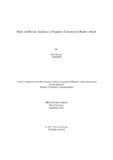| dc.contributor.advisor | Chowdhary, Dr. Suman Paul | |
| dc.contributor.author | Regmi, Rabi | |
| dc.date.accessioned | 2023-03-01T09:40:15Z | |
| dc.date.available | 2023-03-01T09:40:15Z | |
| dc.date.copyright | 2022 | |
| dc.date.issued | 2022-09 | |
| dc.identifier.other | ID: 20264058 | |
| dc.identifier.uri | http://hdl.handle.net/10361/17932 | |
| dc.description | This internship report is submitted in partial fulfillment of the requirements for the degree of Masters of Business Administration, 2022. | en_US |
| dc.description | Cataloged from PDF version of internship report. | |
| dc.description | Includes bibliographical references (pages 49-52). | |
| dc.description.abstract | This is the study conducted to analyze the stocks of Nepalese commercial banks on the basis
of stock return and risk. The study mainly focused on two areas, firstly, it tries to find out and
focuses on identifying the firm-specific variables and their influences on return and risk to the
investors. It is studied to determine the relationship between different variables and their
significance on return/risk. Secondly, based on the return is derived based on dividends earned
and capital appreciation or depreciation realized at the closing date of each fiscal year from
2017 to 2021. It calculated expected return (mean return), standard deviation, variance,
coefficient of variation, correlation of banking sector, market, and each individual selected
bank for analysis. It also calculated and segregated diversifiable and undiversifiable risk in
each stock, the beta of each stock and sector to find out whether aggressive or defensive stock
and the CAPM model to find out over or underpriced stock.
The study found that EPS, P/E ratio, ROA, NPL, Market coverage with branches, and firm size
have significant influences on risk/return. And ROE, Net worth, Capital, loan mobilization,
firm age, and growth rate were found to be insignificant effects on risk/return. It has been found
that only NIC Asia bank is performing better than the banking sector and has the lowest risk
per unit of return. PRVU bank, Nepal bank, GBIME bank, and Kumari banks were found to be
performing better in terms of risk and return. The whole banking sector was found to be a
defensive sector with a sector beta of 0.69 and almost all banks except Kumari and PRVU
banks were found defensive stock. Most of the banks were also found to be having a greater
percentage of systematic risk, only NIBL, NMB, NICA, and PRVU have a higher percentage
of unsystematic risk which can be diversified as the market just fell from the bullish trend cycle
most stocks found to be overpriced and earning less than the required rate of return. | en_US |
| dc.description.statementofresponsibility | Rabi Regmi | |
| dc.format.extent | 55 pages | |
| dc.language.iso | en | en_US |
| dc.publisher | Brac University | en_US |
| dc.rights | Brac University Internship reports are protected by copyright. They may be viewed from this source for any purpose, but reproduction or distribution in any format is prohibited without written permission. | |
| dc.subject | Return/risk | en_US |
| dc.subject | Influencing factors | en_US |
| dc.subject | Significance | en_US |
| dc.subject | Standard deviation | en_US |
| dc.subject | Variance | en_US |
| dc.subject | Betas | en_US |
| dc.subject.lcsh | Capital market. | |
| dc.title | Risk and return analysis of Nepalese commercial bank’s stock | en_US |
| dc.type | Internship report | en_US |
| dc.contributor.department | Brac Business School, Brac University | |
| dc.description.degree | M. Business Administration | |

